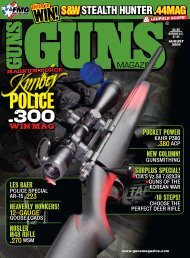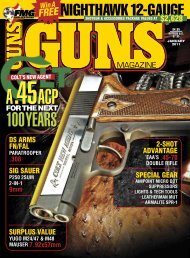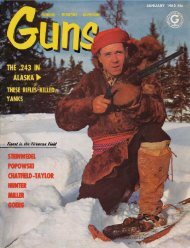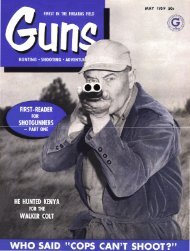Guns 2012-08.pdf - Jeffersonian
Guns 2012-08.pdf - Jeffersonian
Guns 2012-08.pdf - Jeffersonian
You also want an ePaper? Increase the reach of your titles
YUMPU automatically turns print PDFs into web optimized ePapers that Google loves.
Rifles<br />
Don’t be fooled by<br />
the many enduring myths.<br />
One persistent myth is pronghorns have 8X<br />
eyesight. They do have very good eyesight, but<br />
a human with an 8X binocular can see better.<br />
In almost 40 years of pronghorn hunting, John<br />
has only shot at two bucks more than 400 yards<br />
away, and both were dropped with one shot.<br />
One was taken at 401 laser yards with a .257<br />
Weatherby Magnum (above), the other at 430<br />
long paces with a .257 Roberts (below).<br />
John Barsness<br />
ne of the interesting things about growing up in<br />
OMontana has been encountering many hunters from<br />
other parts of North America who finally make their big<br />
trip Out West. This first hunt often involves pronghorn and<br />
mule deer, but for some reason the boys really obsess<br />
over exactly the right pronghorn rifle, perhaps because<br />
mule deer are, well, deer.<br />
Unlike deer, pronghorns live out<br />
in the open where we can see them.<br />
Consequently hunters tend to take<br />
longer shots at pronghorns than any<br />
other North American big game<br />
animal, even though it really isn’t<br />
necessary.<br />
These days most whitetail hunting<br />
means sitting in some sort of stand,<br />
waiting for deer to wander out of the<br />
woods, so many visiting hunters have<br />
little idea of how to stalk a big game<br />
animal. Neither do many hunters<br />
who grew up on the high plains of<br />
the West, due to growing up stalking<br />
from a pickup truck. As a result, both<br />
types of hunters often start shooting<br />
at pronghorns as soon as they spot<br />
one, partly because most antelope are<br />
already onto them. The boys figure<br />
they have to shoot now!<br />
Here it should be mentioned that<br />
while “pronghorn” is supposedly<br />
the “correct” common name for our<br />
quarry, something often pointed out<br />
by pedantics, the scientific name is<br />
Antilocapra americana. This Latin<br />
literally translates into American<br />
antelope-goat, so yeah, it’s perfectly OK<br />
to call pronghorns antelope—or even<br />
goats, one of their common Western<br />
names. In fact we often call them speedgoats<br />
or stink-goats, depending on how<br />
close we get.<br />
The reason so many pronghorn<br />
hunters emphasize high-magnification<br />
scopes and high-velocity cartridges<br />
is they’re not very good at stalking<br />
unalarmed antelope. Pronghorn<br />
hunting actually starts with<br />
binoculars, so we can see pronghorns<br />
before they see us.<br />
You’ve probably heard the myth that<br />
antelope have “8X binocular eyes.” This<br />
arose from something written by Jack<br />
O’Connor, who mentioned glassing<br />
with an 8X binocular and finding a<br />
buck looking right back at him. He<br />
concluded antelope have vision at<br />
least that good—and the myth entered<br />
American hunting lore.<br />
Antelope do have very good eyesight,<br />
but it doesn’t magnify anything. Like<br />
most prey animals, they see movement<br />
really well, especially movement on<br />
a high-plains horizon. If you really<br />
believe in the mythical 8X story, go<br />
ahead and bring a good 10X binocular,<br />
but a good 8X or even 7X binocular<br />
also works well, if you don’t hunt by<br />
hiking ridgelines or driving ranch roads<br />
until some speed-goats spot you.<br />
The trick is to glass constantly,<br />
long before you see any antelope with<br />
your naked eyes, peeking from behind<br />
rocks or sage, to break up the outline<br />
of your head and shoulders. Often<br />
they’ll appear as distant white dots,<br />
but on cloudy days even their tanand-white<br />
coloration tends to merge<br />
with sagebrush, requiring very careful<br />
glassing.<br />
Once a buck’s located, the next<br />
step is to get close enough for a shot,<br />
and in some country this can occur as<br />
soon as you’ve spotted them. Back in<br />
the mid-1980s, before every particle of<br />
Montana’s public pronghorn country<br />
42<br />
WWW.GUNSMAGAZINE.COM • AUGUST <strong>2012</strong>

















